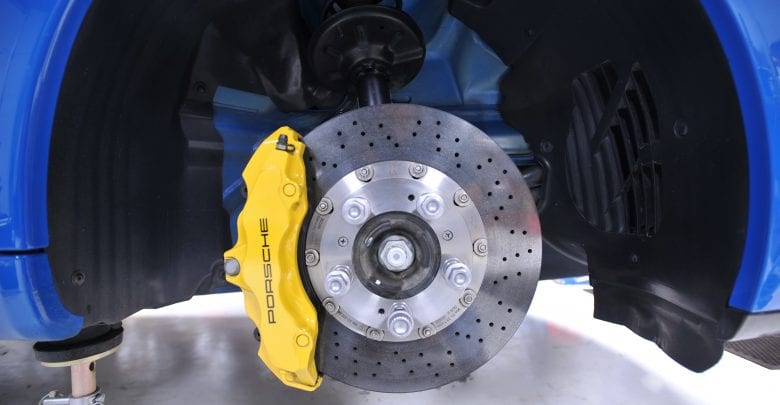
Brake Maintenance: Essential Tips for Keeping You Safe
كيف تحافظ على فرامل السيارة
When the average person thinks of doing the maintenance on their used vehicle, they think of checking the tires, belts, coolant level, but not always brake maintenance. Many people don’t know what signs to look for when their brakes need to be serviced. Keep reading to find out what these signs mean for your safety and what you should be doing to keep your brakes in optimal condition.
Brake Maintenance Begins with Understanding How the System Works
It’s important to know what to look for, and especially how to fix your brakes once you’ve identified the problem. Today, we want to have a look at the components of your brake system, how to fix your car brakes, and a few brake maintenance tips to help each of them function optimally throughout the life of your vehicle.
Brake Fluid Maintenance
The brake fluid reservoir holds all of the fluid that is not currently in a brake line. It’s located under the bonnet and helps maintain the pressure in your brake system in addition to holding all of the excess fluid. Maintaining this section of the system is simple. Look for obvious leaks and cracks and check the fluid level once a month. Consult your owner’s manual for the correct type if you need to add more fluid. One key thing to remember is that brake fluid attracts and absorbs water that could rust the metal sections of your brake lines, causing them to rupture. You can avoid this by making sure the reservoir cap is always on tight. It’s a good idea to change your brake fluid every two years or 40,000 km.
You can easily change the brake fluid yourself by following these five simple steps:
The first step is to find the bleeder screw on the back of each brake. Make sure you have the right size tool to unscrew it. Using the wrong size tool can cause you to strip the bleeder, resulting in a trip to a repair shop. The bleeder tool is a specialty tool that’s not a basic tool kit item, so you may have to go out and buy one.
Starting with the driver’s side front, open the bleeder screw slightly. Have a friend pump the brakes while you pour new fluid into the reservoir. Tip: attach a rubber hose to the bleeder and drain the fluid into a jar to prevent ground contamination.
When the brake fluid runs clean, tighten the bleeder and wipe it clean.
Move to another wheel and begin the process over.
When you are finished with all four wheels, pump the brakes a few times to check for pedal pressure, then look underneath to see if any bleeder screws are leaking.
Master Cylinder Maintenance
The master cylinder creates the pressure that forces the brake fluid currently being used throughout the system. If your brake pedal feels spongy when you stop or the check engine light comes on, that’s an indicator that something’s wrong with your cylinder. There really isn’t anything you can do to maintain the master cylinder aside from making sure there are no obvious leaks in the area. If you do find a leak, it may be time to replace it. In that case, it’s a good idea to hire a professional to do the work for you.
Brake Line Maintenance
The brake lines for your vehicle are made of two different materials—steel and rubber. High-pressure steel lines carry the fluid in most areas, but rubber lines are used near the wheels so that the lines can move as you steer. Changing your brake fluid can help these lines last longer; however, the best you can do is look for puddles near a line (this means there is a large hole in a line) or look for wetness on the inside of your wheels when it is not raining. This is a sign that a rubber line could have a hole in it, and leaks when you press the brakes.
Brake Pad Maintenance
The brake pads, or brake shoes, press against the rotors to make the vehicle stop. When they wear you can end up with a range of issues from just a little noise to complete failure. Luckily, they are easy to keep an eye on. If you have the right kind of car like a Honda Civic, you can see the pads without having to take the wheels off. If not, you may have to remove each wheel individually to see them. Once you can see the pads, make sure there’s at least 5 mm on both, and look for even wear across each pad. Unless you hear a lot of noise, have trouble stopping, or the steering wheel shakes when you brake, you only need to check the pads every 10,000 km. You can find Honda Civicmore information on how to care for your vehicle’s brake pads here.
Rotor Maintenance
This is the metal disk that the brake pads press against when you push the brake pedal. While you are looking at the pads, it’s a good idea to check your rotors as well, especially if you end up having to remove the wheel. Look for grooves in the rotor. Look for the worst case scenario, too, and make sure the rotor isn’t broken in any way. If it’s not perfectly round, replace both rotors on the end of the car. For example, you should always replace the rotors in pairs—either both front rotors or both rear rotors. This ensures that both rotors wear evenly, and creates an even gripping surface on both sides of your car, avoiding any odd pulling to one side while braking.
Stay Safe by Following Your Car’s Brake Maintenance Schedule
With your life and the lives of your passengers depending on the functionality of your car’s safety systems, it’s extremely important to follow the brake maintenance schedule provided in your owner’s manual. Your car’s brake system should take priority in your regular maintenance routine, and it’s something that anyone can do, regardless of skill level. These tips are fairly easy and relatively quick, inexpensive, and the parts can easily be bought online. All these checks can be finished in an hour or two, depending on whether or not you’re chanparts can easily be bought onlineging the brake fluid. If you are preparing for a long road trip or simply want more advice on routine maintenance in addition to brakes, be sure to check out our other maintenance tips articles.
الفرامل جزء مهم في السيارة، قد يؤدي وجود خلل فى الفرامل للحوادث، لذا يحب عليك كسائق سيارة الحفاظ على الفرامل لتجنب هذه الحوادث، يجب عليك الكشف على تيل الفرامل كل 3 أشهر والكشف على خزان زيت الفرامل ومتابعة وجود أي نقص في مستوى الزيت، حيث توجد علامتين واحدة توضح المستوي الأعلى للزيت والتانية بتوضح أقل مستوى له، وفي حال كان الزيت أقل من علامة المستوي الأدنى يجب زيادته ليصل للحد المطلوب، حتى لا تتعطل المكابح في حال النقصان.
حال وجود نقص في خزان الزيت، وقمت بإضافة النقصان من الزيت يجب الاهتمام ومتابعة الخزان حتى تطمئن على عدم وجود تسريب للزيت من الخزنة، مما قد يؤدي إلى تسريب الزيت بالكامل دون أن تشعر، مما يؤدي إلى تعطل المكابح المفاجئ أثناء السير.
دوام فحص الاسطوانة الرئيسية للفرامل للتأكد من عدم وجود أعطال بها، لأنها المسؤولة عن تقليل الجهد المبذول من السائق عن طريق نقل الضغط الهيدروليكي لزيت الفرامل.
في سيارات الجير الأوتوماتيكي لا تضغط على دواسة الفرامل أثناء الانتظار عندما يكون الفتيس في وضع D.
فرغ الهواء الزائد بدائرة عمل الفرامل بعد أي أعمال صيانة مما يعطي أداء أفضل للمكابح.



